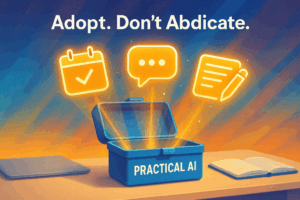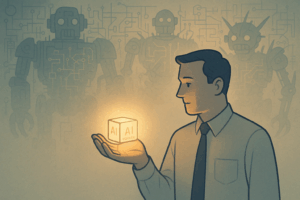The AI landscape is moving fast. So fast, in fact, that many mid-sized businesses are left wondering whether they’re behind or just missing the point. In reality, you don’t need an R&D lab or a team of data scientists to benefit from artificial intelligence. As Brandon Cross puts it, “The simplest tools are often the most effective.”
The Confusing Middle Ground
AI adoption often seems polarized: on one end, highly technical teams chase bleeding-edge models and complex integrations. On the other, non-technical users are quietly crushing it with basic AI tools for writing emails, summarizing calls, and managing calendars. The irony? The less technical you are, the more likely you are to benefit from the current wave of AI tools.
Practical Wins for Non-Technical Teams
Brandon points out that marketing, sales, and customer service are already being transformed by AI.
These aren’t theoretical changes, they’re happening now:
- Marketing Copy: Teams are using AI to write blog posts, social content, and ad copy faster than ever.
- Customer Outreach: AI helps automate cold emails, personalize messaging, and streamline follow-ups.
- Front Desk Support: AI-driven reception systems can answer calls, triage requests, and route inquiries, all at once.
Don’t Overbuild – Optimize
One of the biggest risks mid-market companies face is trying to do too much, too soon. Complex AI initiatives with unclear ROI are a recipe for wasted time and money.
Instead, focus on clear, repeatable tasks:
- Handling inbound customer inquiries
- Routing service tickets or calls
- Creating personalized but scalable outbound communication
These are places where AI can create tangible value almost immediately
What About the Tech Teams?
Technical users often bring pride and perfectionism to the table – and that’s not a bad thing. But it can sometimes lead to over engineering. Brandon highlights the frustration many tech teams face when their AI projects fall short of expectations. Meanwhile, the business teams are winning small, fast, and often.
The lesson? Simplicity scales.
Guardrails and Guidelines
Yes, AI can disrupt jobs. Receptionists and support staff are likely to feel the shift first. But that doesn’t mean we replace people, it means we reposition them.
The key is to create thoughtful frameworks for AI use:
- Ensure AI tools are compliant and transparent
- Avoid handing full control to automation without oversight
- Define the boundaries of what AI should – and shouldn’t – do
Final Thoughts: Adopt, Don’t Abdicate
AI isn’t some distant innovation. It’s already here; writing emails, answering calls, and improving customer experiences. For mid-market organizations, the trick isn’t to go big. It’s to go smart.
Start small. Choose tools that make life easier. Focus on ROI. And above all, keep it simple.

At Hoyack, we help businesses cut through the AI noise. If you want to explore practical AI strategies that move the needle—without overcomplicating your tech stack – we’re here to help.




